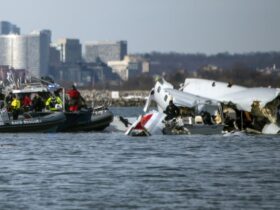Adam Fox grabbed the nets and the cage from the back of his pickup truck. Something in the sand was disturbing the iconic Southern California scenery at the Santa Monica Pier on Friday morning.
A sea lion washed up on the beach just north of the Ferris wheel. It was alive but gravely ill and in a disoriented, near-comatose state. On the other side of the pier, another sea lion lay in the sand, a little more alert but still sick.
Mr. Fox, who works for a sea-mammal rescue group, rushed to help save the animals and transport them to get treated. Both sea lions were given ID numbers, which told a story.
They were tagged as 25-193 and 25-195 — the group’s 193rd and 195th patients of the year.
All along the Southern California coastline from San Diego to Santa Barbara, hundreds of animals — sea lions, dolphins, seabirds — are washing up on the sand either dead or seriously ill. Coastal researchers and officials say it’s become a marine-life crisis that has overwhelmed rescue organizations, distressed beachgoers and hurt California’s ocean habitat.
The cause is a neurotoxin produced by an algae bloom. The toxin, known as domoic acid, is harmless to fish but can be deadly to sea mammals. Fish carry the toxin, but if mammals and birds eat the fish, the toxin can poison them, causing seizures, making them behave erratically or putting them in a coma. The only treatment is to flush out the toxin and medicate the symptoms.
Algal blooms are not rare in California, but the amount of toxic acid the blooms have been releasing and the scale of harm they have been causing to sea life have puzzled scientists.
“We’ve been seeing more toxin both in the organism itself and then also in the animals that are acquiring it,” said Clarissa Anderson, the director of the Southern California Coastal Ocean Observing System, which monitors ocean conditions. “They seem to have more toxin in their tissues. So it may be that the naturally occurring plankton is starting to produce more toxin over time, and that might be why we see more impacts.”
Experts said there are several theories but no definitive answers about the reasons for the severity of the toxin turning up along the Southern California coast. Some say it has to do with climate change and warming sea temperatures. Others say the nutrients in the runoff from land can stimulate algae blooms.
Scientists with the National Oceanic and Atmospheric Administration are studying whether the washed-out ash and debris from the Los Angeles wildfires in January may have influenced the current bloom, according to Michael Milstein, an agency spokesman. More research is needed to understand the changing blooms, research that is largely funded by NOAA and has come under threat. The Trump administration laid off more than 1,000 workers at the agency and vowed to undertake more cuts.
“We have quite a few important colleagues who work with us on these issues who have been let go,” Dr. Anderson said of the NOAA cuts.
In recent weeks, the scale of the damage being done to sea life from the spread of domoic acid has shocked researchers and rescuers. SeaWorld in San Diego went from typically fielding 20 animal-rescue calls a day to 100.
“It kind of just happened so quickly,” said Jeni Smith, who leads the SeaWorld rescue team and who had to scramble to order more supplies, including extra fluid bags. “We always have a back stock,” Ms. Smith said of the I.V. bags. “We used our back stock within two days.”
The toxin has been especially devastating to dolphins.
More than 100 common dolphins have washed up on the beaches. Researchers have hypothesized that the change might have to do with the bloom occurring farther off shore, where dolphins are common. Unlike sea lions, dolphins that become stranded after ingesting a sizable amounts of the toxin almost always have to be euthanized. Sea lions fare better, with a 60 percent chance of survival if treated in a timely manner.
Local governments have put out advisories warning the public not to come close to stranded animals. As the springtime weather brings crowds out to the beaches, parts of the shoreline of Southern California have had a grim feel. Creatures that typically give children and adults a thrill when they’re spotted splashing in the water now turn up in the sand dazed or dead, spreading a sadness that clashes with the bright sunshine and ocean breeze.
One morning last week, Mike Walsh, 58, was on a stroll along the water in Manhattan Beach, a small community south of Los Angeles International Airport. He was listening in on a work call and walking past the volleyball nets when he noticed a sea lion close to a walkway separating the homes from the sand.
“To me, that was strange,” Mr. Walsh said. “Either strange or impressive how far away it got from the beach.”
He snapped a photo and alerted a lifeguard. He continued on his walk when he came upon another surprise: a second ailing sea lion in the sand, this one being helped by rescuers.
In Los Angeles County, the primary rescue organization is the Marine Mammal Care Center, the nonprofit group in San Pedro where Mr. Fox works.
Mr. Fox, a 44-year-old who left a career in fine art 16 years ago to work with wildlife, is one of five rescuers who respond to calls from the field, and he helps coordinate the center’s network of more than 70 volunteers along the county coast line. Though he often comes across animals who are too ill to rescue, he said he tries to embrace the lifesaving part of the job.
“I don’t just want to be the grim reaper of the beach,” Mr. Fox said.
On Friday, a crowded scene unfolded at the rescue center’s headquarters, nestled near a park less than a mile from the shoreline. All the pens and pools were filled with animals, and a fishy smell wafted through the space as veterinarians squeezed by holding syringes or herring filled with medicine.
“Our annual budget is really based around 300 animals a year that come through for rehabilitation,” said John Warner, the chief executive of the Marine Mammal Care Center. “We have already had 200 animals in our care, with the majority of those being from this bloom.”
The cackling cries of abandoned elephant seal pups pierced the air, with the occasional wails from female sea lions thrashing at each other. Sea lions, still dazed by the lingering toxin, can become aggressive for a period as they recover. Recovery can take weeks.
Because of the surge of mammals washing up on the beaches, the center had to expand into an overflow area of its parking lot and set up improvised pens on the wet sidewalk, using sandbags to hold up chain-link fencing.
At the Santa Monica Pier, Mr. Fox pulled his truck near patient No. 25-195, the sea lion that was north of the Ferris wheel. The foaming water at the shoreline lapped under her. She was deep inside a pocket of wet sand. Ash from the nearby wildfire in Pacific Palisades was visible on the sand, but Mr. Fox suspected it was the toxin that sickened her.
He contemplated which of the two ailing sea lions that had washed up on the beach to save first. There was only room in his pickup truck to carry one at a time. “Because that one on the other side is closer to the pier, it’s probably going to cause more problems than this one,” Mr. Fox said.
So he left that sea lion, and returned to 25-193 on the other side of the pier. He flung an oversized net around the mammal. The animal jerked, trying to escape, but gave up after a short time.
He dropped it off at the rescue center in San Pedro, and then slogged through traffic heading back to the beach in Santa Monica, his cellphone buzzing along the way with updates on ongoing cases. Hours had passed by the time he made it back to the other sea lion, No. 25-195. She had perked up and moved away from the water.
Mr. Fox had help this time from a lifeguard and a volunteer as a few beachgoers looked on. Out came the rubber-wheeled cage: a custom-built aluminum box that resembled a metal chest with air holes. They got the sea lion inside and pushed it up a ramp onto the truck bed.
At the rescue center, veterinarians examined both animals. Patient No. 25-195 was pregnant, which meant the fetus would have to be aborted for her to survive. Both sea lions have a good chance of surviving, rescue center officials said. Throughout the weekend, they were stable and resting.
Eventually, they gained some identity, too. They were 25-193 and 25-195 no more. Now they’re Carlin and Kelley.












Leave a Reply